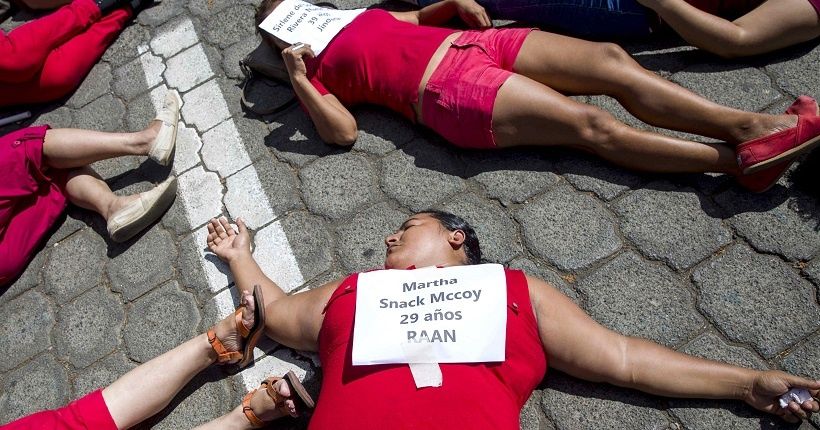Machismo and femicide – deadly partners

In Latin America, violence against women and girls is pervasive and practiced with relative impunity. According to a November 2017 United Nations Development Program Report, Latin America has the highest rate in the world of gender-based sexual violence against women, and in Central America two of every three women killed are victims of femicide, while the Economic Commission for Latin America and the Caribbean found that on average 12 women are murdered a day across the region.

The acceptance of violence against women is linked to the culture of machismo in Latin America: a recent report by Oxfam surveyed young people aged 15 to 25 from eight Latin American and Caribbean countries and found that machismo is tolerated by many young people in the region, with 86% of the young people surveyed believing their friends would not intervene if a friend hit his girlfriend. This normalization of violence against women has grave consequences for women and girls.
In order to bring to light overlooked and underreported instances of extreme violence against women, in the past decade many countries in Latin America have introduced a new category of homicide called “femicide.” The internationally accepted definition of femicide is the murder of a woman or girl for the fact that she is a woman.
legal variance
However, there is no regional legal consensus on what constitutes femicide, and each of the sixteen countries that have included it in their penal code uses a different definition. For example, Nicaragua has an appropriately expansive definition, wherein the murder of a woman is classified as a femicide if it is driven by circumstances including any relationship with the perpetrator, unsuccessful sexual pursuit, gang violence, misogyny, or even if it is committed in front of the woman’s children.
On the other hand, for a murder to be counted as a femicide in Mexico, the victim must either show signs of sexual assault or mutilation or have had a close relationship to the perpetrator.
In Chile, the woman must have been the spouse or cohabitator of the perpetrator. The regional definitional divide in femicide classification results in inconsistent legislation. Simply having a consistent definition for femicide could help identify trends and regional best practices to address violence against women.
The lack of consensus over the definition also thwarts the effort to collect statistics on femicide that can be compared across countries. Collecting data is critical for researchers to measure the severity of gender-related violence and to monitor rates to identify progress.
However, official statistics are scarce, and the differing definitions of femicide make it impossible to make country comparisons. For example, the Ministry of Peru has created a Feminicide Registry that clearly categorizes three types of femicide: intimate femicide, non-intimate femicide, and femicide based on connections.
These subcategories are then compiled to record an official national number. If the entire region adopted such a methodology, steps could be taken to understand where, why, and how femicide happens, and implement an evidence-informed policy to better combat it.
Police training
Another issue underlying data collection is the lack of police training to correctly identify femicide, which results in underreporting. According to a recent report by Mexicans Against Corruption and Impunity, for example, only 20% of the over ten thousand murders of women between 2012 and 2016 were investigated as femicides. It is important that police officers, crime scene investigation officials, and forensic experts are properly trained to identify and report femicide. Some countries like Guatemala have established special units to investigate cases of violence against women. These units are staffed by police officers and other personnel that have received training on gender issues and human rights.
Data collection on femicide is also critical for informing preventative policies. Although preventative measures are being taken in many countries, data can inform more effective and targeted policies. For example, beginning in 2006, Chile developed “Casas de Acogida” or shelter homes for women under life-threatening situations due to intra-family violence. Data could be used to dedicate more staff and resources to shelters in areas with higher femicide rates.
However, even the most well researched, coordinated, and drafted laws are worthless if governments do not dedicate resources to implementing them. For instance, in El Salvador, which passed a law criminalizing femicide in 2011, in the first 16 months after the law was enacted only 16 of the 63 reported cases were solved due to a systematic lack of investigation by police. According to the United Nations, as many as 98% of the cases of femicide and violence against women and girls in Latin America went unpunished in 2016. This may be due to policy “slippage” which is caused by the insufficient commitment of funds by the government to build up institutions to monitor the enforcement of newly enacted femicide laws.
The shocking level of impunity cannot solely be attributed to a lack of resources. Impunity is rooted in a lack of political will—to adequately organize resources and initiatives and mechanisms for the protection of women and their access to justice. Silvia Juarez, a member of the Organization of Salvadoran Women for Peace commented that although the government enacted legislation, there is “ignorance of the existence of the law, and resistance in applying it. The work does not end with the law being passed.” Cultural values and public support influence the success of policy implementation. In order to address the root causes of femicide, Latin America will ultimately need to confront the entrenched culture of machismo. Nonetheless, formalizing and building consensus around the definition and legislation of femicide could be the first step in bridging the legal gaps and generating the data needed to identify and deploy preventive policies to better protect women and girls in Latin America … THE INTER-AMERICAN DALOGUE





